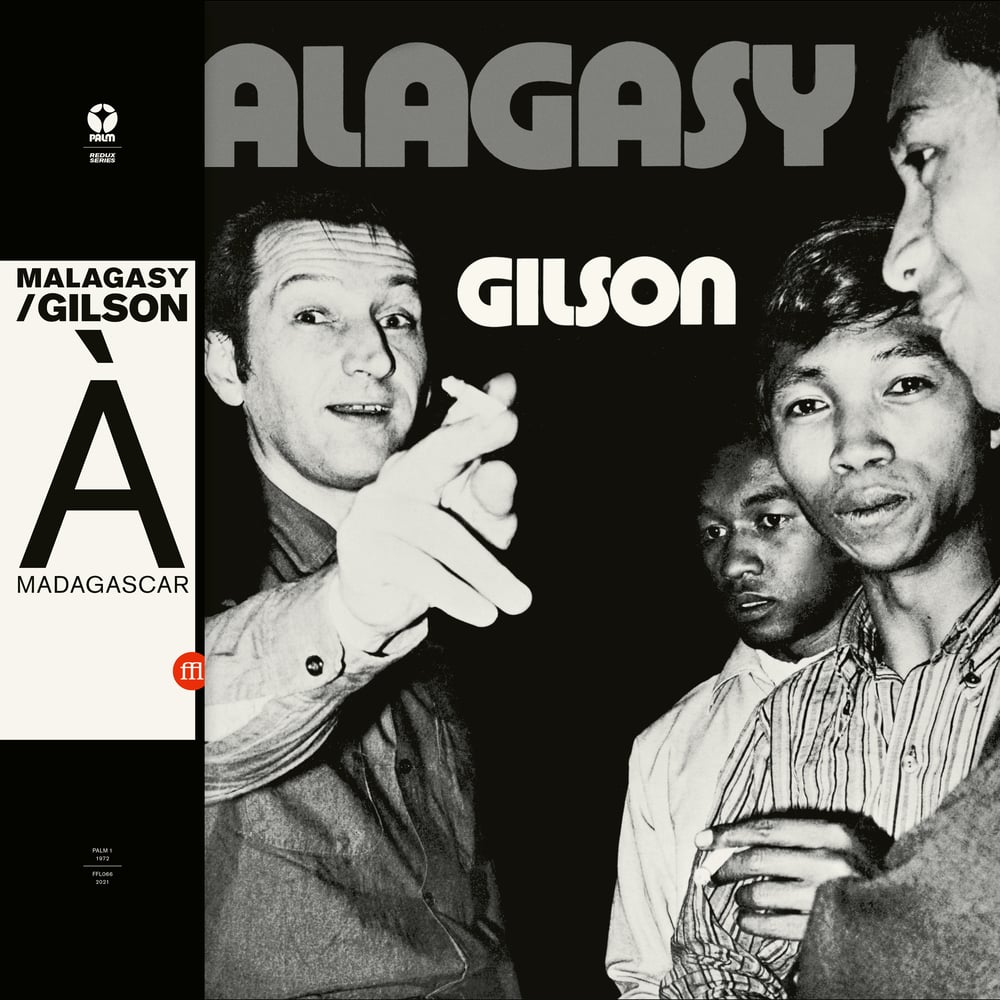Malagasy / Gilson - Malagasy (FFL066)
23,00 €
PRE ORDER - SHIPPING JUNE 18TH
First ever standalone vinyl reissue
Carefully remastered
4 page booklet with rare and unpublished photos
Heavyweight 180 gr. LP
Paris, May 13th 1968. There was a general strike. One last plane left the runway, strewn with flaming oil drums. On board were three jazz musicians wondering whether they would be able to return home one day. But for the time being they really want to make it to Madagascar where concerts and workshops with young local musicians were waiting for them. Pianist and bandleader Jef Gilson was accompanied by his bassist Gilbert "Bibi" Rovère (Martial Solal Trio) and the young drummer Lionel Magal (Crium Delirium). Gilson, who already had a reputation for finding new talent (it was thanks to him that, amongst others Jean-Louis Chautemps, Henri Texier, Jean-Luc Ponty or Michel Portal first became known) was literally blown away by the standard of the young Malagasy musicians, all capable of imitating their American idols by ear. Their names were known only to jazz fans on the island; Serge, Allain and Georges Rahoerson, Arnaud Razafy, Roland de Comarmond, Joel Rakotomamonjy, Alain Razafinohatra, Samuel Ramiara... Gilson then had a vision: he wanted to encourage them to play jazz which was truly Malagasy and which would find its’ soul in the island’s culture and traditional instruments (Sodina flute, valiha, various percussion instruments...).
He would go back to the big island three times, in March (with cellist Jean-Charles Capon), in October 1969 (alone), then in February 1970 (as a trio with guitarist Raymond Boni and drummer Bertrand Gauthier). The two trips in 1969 would lead to the sessions, recorded on a simple ReVox with two Neuman microphones, which would make up the essential part of this mythical album entitled "Malagasy", and first issued in 1972 on the Lumen label, and then reissued, as early as 1973, on Palm, Jef Gilson’s own label.
Apart from the last track, recorded in Paris in 1971 with Malagasy instruments brought back from trips by the trio which would play on the avant-garde "Le Massacre du Printemps" (Futura), all the other compositions on the album are by Jef Gilson, Jean-Charles Capon and the young saxophonist Serge Rahoerson. There is also a cover of a song issued just a few months earlier and that the Malagasy musicians had only heard through bits and pieces played by Gilson on piano: the song is "The Creator Has A Masterplan" by Pharoah Sanders, and it is one of the most wild and mystical versions you will ever hear.
In May 1972, Madagascar itself would be the theatre of youth revolt. And the composition "Avaradoha" by Serge Rahoerson, the second track of the first side of this album, would be the anthem of the revolution on the streets.
*
Paris, le 13 mai 1968. C'est la grève générale. Un dernier avion quitte précipitamment le tarmac jonché de bidons en flammes. A bord, trois musiciens de jazz se demandent s'ils pourront rentrer chez eux un jour. Mais pour l'heure ils ont surtout hâte d'arriver à Madagascar où les attendent concerts et ateliers avec de jeunes musiciens locaux. Accompagné de son bassiste Gilbert « Bibi » Rovère (Martial Solal Trio) et du jeune batteur Lionel Magal (Crium Delirium), le pianiste et chef d'orchestre Jef Gilson, pourtant déjà réputé pour révéler de nouveaux talents -on lui doit alors les débuts, entre autres, de Jean-Louis Chautemps, Henri Texier, Jean-Luc Ponty ou Michel Portal- sera littéralement bluffé par le niveau des jeunes instrumentistes malgaches, tous capables d'imiter à l'oreille leurs idoles américaines. Leurs noms ne sont connus que par les amateurs de jazz de l'île : Serge, Allain et Georges Rahoerson, Arnaud Razafy, Roland de Comarmond, Joel Rakotomamonjy, Alain Razafinohatra, Samuel Ramiara... Gilson a alors une vision : il veut les exhorter à jouer un jazz qui serait véritablement malgache, qui puiserait son âme dans la culture de l'île et ses instruments traditionnels (flûte sodina, valiha, percussions diverses...).
Il reviendra trois fois sur la grande île, en mars (avec le violoncelliste Jean-Charles Capon) et octobre 1969 (seul), puis en février 1970 (en trio avec le guitariste Raymond Boni et le batteur Bertrand Gauthier). Des deux séjours de 1969, naitront les sessions, alors enregistrées sur un simple ReVox avec deux micros Neuman, qui formeront l'essentiel de cet album mythique baptisé « Malagasy », et sorti dans un premier temps en 1972 sur le label Lumen, puis réédité dès 1973 sur Palm, le propre label de Jef Gilson.
Hormis le dernier titre, enregistré à Paris en 1971 avec des instruments malgaches ramenés de ses voyages par le trio qui jouait sur l'avant-gardiste « Le Massacre du Printemps » (Futura), toutes les autres compositions du disque sont de Jef Gilson, Jean-Charles Capon et du jeune saxophoniste Serge Rahoerson. On trouve aussi une reprise d'un titre, sorti quelques mois plus tôt seulement, et que les Malgaches n'ont pu entendre avant l'enregistrement que par bribes jouées au piano par Gilson : c'est « The Creator Has A Masterplan » de Pharoah Sanders, dans une des versions les plus sauvages et les plus mystiques que vous entendrez jamais.
En mai 1972, c'est Madagascar qui connaîtra à son tour la révolte de la jeunesse. Et la composition « Avaradoha », signée Serge Rahoerson, en deuxième plage de la première face de cet album, sera l'hymne de la révolution dans les rues.
Jérôme « Kalcha » Simonneau
.33rpm.
©2021 SouffleContinu Records
Licensed from Palm / Geneviève Quievreux
-
If you want registered shipping,
please contact us at:
[email protected]
We can’t guarantee delivery or refund without registered shipping. Sorry about that.


